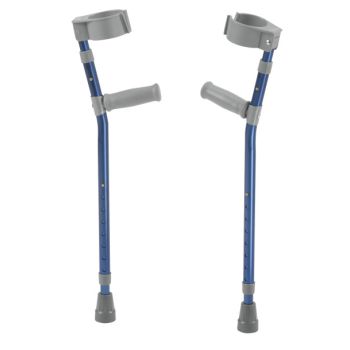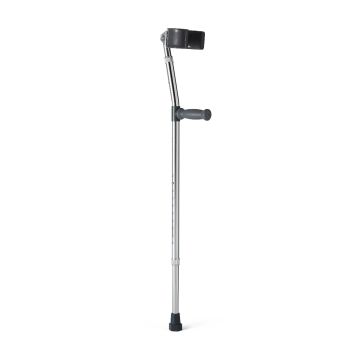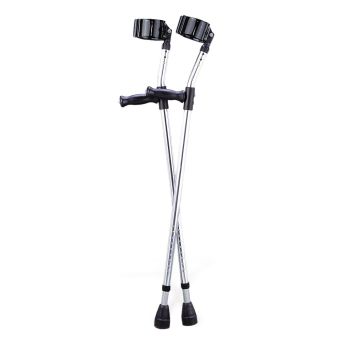Free shipping orders over $50
Adjustable Crutches / Adjustable Forearm Crutches
While some crutch models don’t state specifically that they are adjustable crutches, product manuals usually tell users how to adjust the crutches. Our selection of adjustable crutches include crutches from Drive Medical, Cardinal Health, and Medline. Some people may have trouble adjusting their crutches and wonder how to properly adjust crutches when they buy new ones. Sounds like you? Then read on to learn how to adjust crutches easily! Read More...
-
McKesson Underarm Crutch w Eurostyle Clip
Starting at $28.37 -
McKesson Push Button Aluminum Crutches
Starting at $40.36 -
Carex Aluminum Push Button Crutches
Starting at $46.38 -
Bariatric Heavy-Duty Crutches
Starting at $53.83 -
Push Button Adjustable Crutches
Starting at $32.98 -
Pediatric Forearm Crutches
Starting at $88.40 -
Standard Aluminum Crutches
Starting at $20.90 -
Red Dot Aluminum Crutches
Starting at $21.14 -
Adult Bariatric Crutches
Starting at $54.21 -
Medline Forearm Crutches
Starting at $35.55 -
Guardian Forearm Crutches
Starting at $40.48 -
Lightweight Forearm Crutches
Starting at $75.40
What Are Adjustable Crutches?
Adjustable crutches come in two primary types – forearm and underarm crutches. Both help to improve and increase mobility and aid in recovery from non-weight bearing leg injuries or disabilities. Some users are able to bear a little bit of weight on injured limbs, and in these circumstances, adjustable crutches that are for sale can help to reduce the impact that prolonged use and full-weight-bearing would cause. The two types of crutches are a bit different, and they are often adjusted differently as well:
Adjustable Forearm Crutches
When a person uses adjustable elbow crutches, it’s important to maintain the proper crutch adjustment to ensure maximum safety and improve the quality of not only the crutch but also the walking experience during their use. Forearm crutches are also often called double adjustable elbow crutches because in many models, one can do more than merely select the crutches height. They can also adjust the arm cuff, both in height, and many times in tightness, as well. Elbow crutches are made for those who need long-term solutions.
Adjustable Underarm Crutches
Underarm (also known as axillary) crutches are the most common type of height adjustable crutches in use. They are frequently used in short-usage scenarios when one hurts their leg and needs to have zero or very little weight bearing on it. They allow for the crutch height adjustment to fit according to the user’s height and are optimal for temporary use. Comfort grip adjustable crutches are also more widely used in hospitals and medical facilities since they are a standard crutch that many people are familiar with. What’s more, they can often withstand increased weight to accommodate patients of all different sizes.
Does My Doctor Need to Fit Me for Crutches?
The answer to this common question is no. As a matter of fact, crutches themselves don’t even require a prescription. It is recommended that a person ask their doctor to write a prescription to use crutches, though, as there may be many benefits to using them. Users can also learn how to adjust the crutches’ height for their needs as well as learn how to use them. Most doctors are willing and able to teach their patients the proper way to use them, and many even recommend the correct height for their crutches.
How to Measure and Adjust Crutches to Your Height
Many people wonder how to set up crutches. The first step is measuring oneself for a pair of adjustable crutches so they can know how to position themselves correctly on their comfort grip adjustable crutches. This will not only improve comfort and the user experience but can also improve safety. If you’re wondering how to measure crutches, you must also keep in mind that the proper height for crutches depends on each individual user. To measure for adjustable height crutches, one must do the following:
For Axillary (Armpit) Crutches:
1. Position the top of the crutch to about 1.5 – 2 inches below the armpit while standing erect.
2. Make sure that the hand grips are parallel with your hips while you stand straight.
3. When using the hand grips, you should be bending your elbows slightly (at about a 15-degree angle).
4. When leaning into the crutch, make sure that the hand is supporting the weight, not the armpit itself. Otherwise, axillary nerve damage could result.
For Forearm Crutches:
1. First of all, check that the forearm cuff is about 3 inches below the elbow, and then measure the distance between the user’s wrist and floor.
2. Next, you want to measure around the widest part of the forearm to ensure the proper cuff size.
3. Once this is complete, the user can adjust the length of the crutches up or down to allow for their exact needs, ensuring that his or her hands and arms are bearing all of the weight on them.
4. The correct height for elbow crutches depends on the individual user – one will have obtained the correct adjustment when they feel comfortable and somewhat natural while walking. Some users may need to adjust forearm crutches frequently before finding the correct setting for their needs.
How to Properly Adjust Crutches
Both types of crutches have a general push-pin design that is used when adjusting the crutch. In armpit crutches, the push-buttons are located on the bottom-center leg and the height can be adjusted accordingly, as mentioned above. These push pins lock in place into pre-drilled height settings for convenience and security.
1. Simply depress the pin and pull the leg down into the desired hole in order to properly adjust the overall height of the crutch.
2. Hand grips are often fastened and adjusted by a wingnut in the middle section of the crutch itself. Some have a wingnut and a long pin that goes across the entire width of the outer crutch tubes. Others have wingnuts on both sides. If you need to adjust the handgrip, simply loosen the nut, pull the rod out and move the handle to the correct position. Otherwise, loosen the wingnuts on each side and pull the pin out, adjust the hand grip accordingly, then re-fasten the wingnuts and the rods. Check these nuts frequently to ensure they haven’t loosened over time.
3. Adjust the crutches so they are about 2 inches from your underarms. If you adjust any more, they may cause tripping hazards. If they are too short, however, one can end up being hunched over and suffer from not only axillary nerve damage but also back discomfort.
At AvaCare Medical, we carry some of the best adjustable crutches on the market. Hopefully, you’ve now learnt how to adjust crutches, but if you need to speak with someone who can teach you in detail, our customer care staff can be reached at 1-877-813-7799 during our business hours to assist you with all of your needs! Don’t hesitate to give us a call today and we’ll gladly help you with placing an order or adjusting your crutches!














